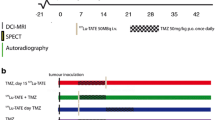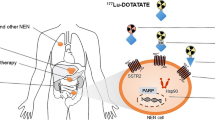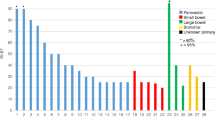Abstract
Purpose
Small cell cancers (SmCC), whether pulmonary (SCLC) or extrapulmonary, have a poor prognosis unless localised at diagnosis. Given a proportion of these cancers express somatostatin receptor subtype 2 (SSTR2), we aimed to investigate the efficacy of targeted peptide receptor chemoradionuclide therapy (PRCRT).
Methods
In this preclinical study, we used a SCLC xenograft mouse model with high expression of SSTR2 to investigate the effect of peptide receptor radionuclide therapy (PRRT) with chemotherapy compared to either alone. We subsequently explored the clinical utility in a patient with SmCC with high SSTR expression treated with PRCRT.
Results
Robust expression of SSTR2 in NCI-H69 SCLC xenografts was documented by 68Ga-DOTA-octreotate (GaTate) (tumour to background uptake ratio = 35). The combination of PRRT using 177Lu-DOTA-octreotate (LuTate) with carboplatin/etoposide (C/E) chemotherapy was more effective than either LuTate or C/E alone for regression of the NCI-H69 model (p value < 0.05). PRCRT was associated with significantly prolonged survival versus PRRT (p value = 0.0001) or chemotherapy alone (p value = 0.0058). In the subsequent case study, a patient with relapsed SmCC with high SSTR2 expression on GaTate PET underwent PRCRT with radiosensitising etoposide with evidence of a complete metabolic response for 4 months.
Conclusion
Given the limited treatment options in this setting, PRCRT is a promising therapeutic option for SSTR2-expressing SmCC.




Similar content being viewed by others
References
O’Brien ME, Ciuleanu TE, Tsekov H, Shparyk Y, Cuceviá B, Juhasz G, et al. Phase III trial comparing supportive care alone with supportive care with oral topotecan in patients with relapsed small-cell lung cancer. J Clin Oncol 2006;24(34):5441–7.
Garassino MC, Torri V, Michetti G, Lo Dico M, La Verde N, Aglione S, et al. Outcomes of small-cell lung cancer patients treated with second-line chemotherapy: a multi-institutional retrospective analysis. Lung Cancer 2011;72(3):378–83.
von Pawel J, Schiller JH, Shepherd FA, Fields SZ, Kleisbauer JP, Chrysson NG, et al. Topotecan versus cyclophosphamide, doxorubicin, and vincristine for the treatment of recurrent small-cell lung cancer. J Clin Oncol 1999;17(2):658–67.
Owonikoko TK, Behera M, Chen Z, Bhimani C, Curran WJ, Khuri FR, et al. A systematic analysis of efficacy of second-line chemotherapy in sensitive and refractory small-cell lung cancer. J Thorac Oncol 2012;7(5):866–72.
Walenkamp AM, Sonke GS, Sleijfer DT. Clinical and therapeutic aspects of extrapulmonary small cell carcinoma. Cancer Treat Rev 2009;35(3):228–36.
Reubi JC, Waser B, Sheppard M, Macaulay V. Somatostatin receptors are present in small-cell but not in non-small-cell primary lung carcinomas: relationship to EGF-receptors. Int J Cancer 1990;45(2):269–74.
Fujita T, Yamaji Y, Sato M, Murao K, Takahara J. Gene expression of somatostatin receptor subtypes, SSTR1 and SSTR2, in human lung cancer cell lines. Life Sci 1994;55(23):1797–806.
Macaulay V, Smith I, Everard M, Teale J, Reubi J, Millar J. Experimental and clinical studies with somatostatin analogue octreotide in small cell lung cancer. Br J Cancer 1991;64(3):451–6.
Taylor J, Coy D, Moreau J-P. High affinity binding of [125 I-Tyr 11] somatostatin-14 to human small cell lung carcinoma (NCI-H69). Life Sci 1988;43(5):421–7.
Erlandsson A, Forssell-Aronsson E, Seidal T, Bernhardt P. Binding of TS1, an anti-keratin 8 antibody, in small-cell lung cancer after 177Lu-DOTA-Tyr3-octreotate treatment: a histological study in xenografted mice. EJNMMI Res 2011;1(1):19.
Sollini M, Farioli D, Froio A, Chella A, Asti M, Boni R, et al. Brief report on the use of radiolabeled somatostatin analogs for the diagnosis and treatment of metastatic small-cell lung cancer patients. J Thorac Oncol 2013;8(8):1095–101.
Imhof A, Brunner P, Marincek N, Briel M, Schindler C, Rasch H, et al. Response, survival, and long-term toxicity after therapy with the radiolabeled somatostatin analogue [90Y-DOTA]-TOC in metastasized neuroendocrine cancers. J Clin Oncol 2011;29(17):2416–23.
Kwekkeboom DJ, de Herder WW, van Eijck CH, Kam BL, van Essen M, Teunissen JJ, et al. Peptide receptor radionuclide therapy in patients with gastroenteropancreatic neuroendocrine tumors. Semin Nucl Med 2010;40(2):78–88.
Pless M, Waldherr C, Maecke H, Buitrago C, Herrmann R, Mueller-Brand J. Targeted radiotherapy for small cell lung cancer using 90Yttrium-DOTATOC, an Yttrium-labelled somatostatin analogue: a pilot trial. Lung Cancer 2004;45(3):365–71.
van Essen M, Krenning EP, Kooij PP, Bakker WH, Feelders RA, de Herder WW, et al. Effects of therapy with [177Lu-DOTA0, Tyr3]octreotate in patients with paraganglioma, meningioma, small cell lung carcinoma, and melanoma. J Nucl Med 2006;47(10):1599–606.
Kong G, Johnston V, Ramdave S, Lau E, Rischin D, Hicks RJ. High-administered activity In-111 octreotide therapy with concomitant radiosensitizing 5FU chemotherapy for treatment of neuroendocrine tumors: preliminary experience. Cancer Biother Radiopharm 2009;24(5):527–33.
Hubble D, Kong G, Michael M, Johnson V, Ramdave S, Hicks RJ. 177Lu-octreotate, alone or with radiosensitising chemotherapy, is safe in neuroendocrine tumour patients previously treated with high-activity 111In-octreotide. Eur J Nucl Med Mol Imaging 2010;37(10):1869–75.
Daniel VC, Marchionni L, Hierman JS, Rhodes JT, Devereux WL, Rudin CM, et al. A primary xenograft model of small-cell lung cancer reveals irreversible changes in gene expression imposed by culture in vitro. Cancer Res 2009;69(8):3364–73.
Kashyap R, Jackson P, Hofman MS, Eu P, Beauregard J-M, Zannino D, et al. Rapid blood clearance and lack of long-term renal toxicity of 177Lu-DOTATATE enables shortening of renoprotective amino acid infusion. Eur J Nucl Med Mol Imaging 2013;40(12):1853–60.
Beauregard JM, Hofman MS, Kong G, Hicks RJ. The tumour sink effect on the biodistribution of 68Ga-DOTA-octreotate: implications for peptide receptor radionuclide therapy. Eur J Nucl Med Mol Imaging 2012;39(1):50–6.
Zhernosekov KP, Filosofov DV, Baum RP, Aschoff P, Bihl H, Razbash AA, et al. Processing of generator-produced 68Ga for medical application. J Nucl Med 2007;48(10):1741–8.
Cullinane C, Dorow DS, Jackson S, Solomon B, Bogatyreva E, Binns D, et al. Differential (18)F-FDG and 3′-deoxy-3′-(18)F-fluorothymidine PET responses to pharmacologic inhibition of the c-MET receptor in preclinical tumor models. J Nucl Med 2011;52(8):1261–7.
Park KS, Martelotto LG, Peifer M, Sos ML, Karnezis AN, Mahjoub MR, et al. A crucial requirement for hedgehog signaling in small cell lung cancer. Nat Med 2011;17(11):1504–8.
Taylor JE, Theveniau MA, Bashirzadeh R, Reisine T, Eden PA. Detection of somatostatin receptor subtype 2 (SSTR2) in established tumors and tumor cell lines: evidence for SSTR2 heterogeneity. Peptides 1994;15(7):1229–36.
Rossi A, Di Maio M, Chiodini P, Rudd RM, Okamoto H, Skarlos DV, et al. Carboplatin- or cisplatin-based chemotherapy in first-line treatment of small-cell lung cancer: the COCIS meta-analysis of individual patient data. J Clin Oncol 2012;30(14):1692–8.
Giocanti N, Hennequin C, Balosso J, Mahler M, Favaudon V. DNA repair and cell cycle interactions in radiation sensitization by the topoisomerase II poison etoposide. Cancer Res 1993;53(9):2105–11.
Johnson DH, Greco FA, Strupp J, Hande KR, Hainsworth JD. Prolonged administration of oral etoposide in patients with relapsed or refractory small-cell lung cancer: a phase II trial. J Clin Oncol 1990;8(10):1613–7.
Marschke Jr RF, Grill JP, Sloan JA, Wender DB, Levitt R, Mailliard JA, et al. Phase II study of high-dose somatostatin analogue in patients either previously treated or untreated who have extensive-stage small cell lung cancer. Am J Clin Oncol 1999;22(1):15–7.
Zarogoulidis K, Eleftheriadou E, Kontakiotis T, Gerasimou G, Zarogoulidis P, Sapardanis I, et al. Long acting somatostatin analogues in combination to antineoplastic agents in the treatment of small cell lung cancer patients. Lung Cancer 2012;76(1):84–8.
Kwekkeboom DJ, de Herder WW, Kam BL, van Eijck CH, van Essen M, Kooij PP, et al. Treatment with the radiolabeled somatostatin analog [177Lu-DOTA0, Tyr3]octreotate: toxicity, efficacy, and survival. J Clin Oncol 2008;26(13):2124–30.
Schillaci O, Corleto VD, Annibale B, Scopinaro F, Delle Fave G. Single photon emission computed tomography procedure improves accuracy of somatostatin receptor scintigraphy in gastro-entero pancreatic tumours. Ital J Gastroenterol Hepatol 1999;31 Suppl 2:S186–9.
Acknowledgments
D. Neil Watkins and Rodney J. Hicks received financial support from the Victorian Cancer Agency.
Conflicts of interest
None.
Author information
Authors and Affiliations
Corresponding author
Additional information
Jeremy Lewin and Carleen Cullinane contributed equally to the results presented in this report.
Electronic supplementary material
Below is the link to the electronic supplementary material.
ESM 1
(JPEG 314 kb)
Rights and permissions
About this article
Cite this article
Lewin, J., Cullinane, C., Akhurst, T. et al. Peptide receptor chemoradionuclide therapy in small cell carcinoma: from bench to bedside. Eur J Nucl Med Mol Imaging 42, 25–32 (2015). https://doi.org/10.1007/s00259-014-2888-2
Received:
Accepted:
Published:
Issue Date:
DOI: https://doi.org/10.1007/s00259-014-2888-2




